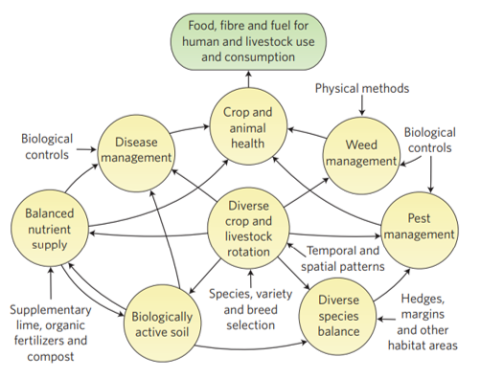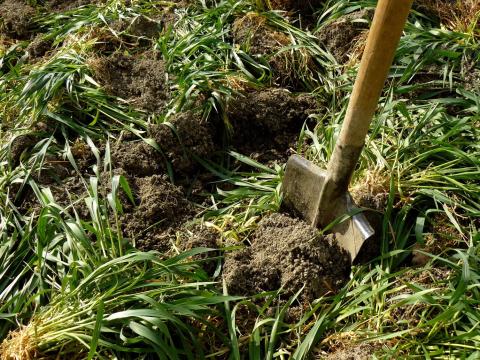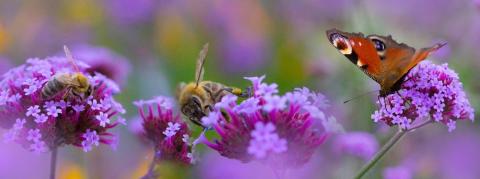14 December 2022
Dr David Cutress: IBERS, Aberystwyth University.
- Organic farming strives to utilise techniques which work in collaboration with local ecosystems
- Organic farming strategies such as crop diversification and rotation can improve field plant diversity levels
- There are other beneficial strategies that we can take from organic farming but these need not be unique to organic systems and could be used in conventional farming too
- Zones and pockets of species-rich regions such as wildflowers and mixtures of grasses, shrubs and tree species (as opposed to monocultures) and restoring portions of semi-natural habitats are highly beneficial to any farming system
Biodiversity is a vital consideration for the function of ecosystems worldwide and in providing the human population with a variety of ecosystem services (such as scenic environments, clean air and clean water). We have discussed broad strategies that could be employed within agriculture to impact biodiversity in the form of land sparing and land sharing, but inside of these strategies, specific farming systems can have further impacts on biodiversity. One of the systems that appears to have significant impacts on biodiversity across its application is the conversion to organic farming. Papers suggest that on average organic farming leads to increases in local species richness and abundance of 34% and 50% compared to conventional systems, but in one of our previous articles, we looked at the impacts of organic farming on climate change and noted some of the complexities of the situation. Whilst many believe organic farming is inherently better for the environment due to fewer synthetic chemicals being applied our article highlights how the situation is far more complex than this. As such this article aims to evaluate if a similar case is true for organic farming and biodiversity and how the benefits of this strategy on broad species diversities truly function.
Why organic farming benefits biodiversity
Generally, organic farming is considered to be far more of a holistic system, being more reliant on the benefits associated with natural ecosystems, as such it should aim to focus on maintaining and boosting these ecosystems. When this is performed in practice organic systems can have a range of benefits both towards and from biodiversity.
Organic farming management Adapted from Reganold and Wachter (2016)
Organic system benefits
Chemicals
The ability to sell produce as organically certified relies on adherence to certification restrictions. A major restriction in organic farming is the range of agrochemical inputs that are available for use and the concentrations at which they can be applied on farms. Meta-analysis studies in the past have suggested that this reduced range of chemicals means holistic farmers use more forethought and planning in their strategies, leading to less blanket chemical applications that damage ecosystems and instead more strategies which utilise ecosystem knowledge, such as biological controls.
Varied crop rotations
A major component of the soil associations' certification of crop farming for organic application in the UK relates to the management of the soil. One of the primary strategies repeatedly advised and discussed, both in the certification literature and in studies promoting organic farming practices for biodiversity, is the drive for varied crop rotations. The targeted rotation of crops in soils has been linked with increasing the biological activity and microbiome functionality and diversity of certain soils whilst also being suggested to have roles in disrupting weed impacts.
Others
Other strategies also exist which are encouraged and more prevalent on organic certified farms but are not inherently part of the certification regulations. As such whilst we consider these here within the benefits of organic systems, they can equally apply to innovative conventional systems.
- The preservation of mixed grazing systems where livestock species are intertwined has been previously assessed and noted to have roles in biodiversity.
- The utilisation of mixed farming systems where crops and livestock species are intertwined has received increasing focus as a self-sustaining, biodiversity-boosting future strategy of circularity
- Sympathetic management of non-cropped habitats and focus on natural landscape elements are highly beneficial towards increasing biodiversity. In some instances, these can go as far as restoration activities as discussed in the land sharing and sparing article.
- Crop diversification strategies inherently have impacts on surrounding biodiversity. Shifting from monoculture crops, such as wheat and grains, to more native and varied crop options provides different habitat niches and feed resources for a wider diversity of organisms to take advantage of within the landscape mosaic. We have also discussed previously the impact of such diversifications for sustainability and economics.
- Smaller field sizes (more common in organic systems) are suggested across the literature to increase biodiversity levels per unit area (due to factors like smaller fields leading to more non-crop habitats like hedge and tree barriers and marginal regions separating individual fields within a landscape leading to fewer biodiversity isolation “islands”)
- Green manure strategies in several studies have been associated with an increase in soil microbial diversity and richness and can prevent the occurrence of bare soils which are implicated in reducing general soil health and fertility
- Lower fertiliser inputs reduce the risk of leaching which can impact water species diversity. Higher nutrient levels change soil microbiome populations impacting the diversity of associated fauna and flora.
- Use of organic manure is linked with beneficial shifts and changes to the microorganisms in the soil in several experiments compared to synthetic fertilisers. Importantly though, analysis of manure nutrient levels can be key to ensure too much fertilisation input is not applied leading to the detriments discussed above.
Debate surrounding organic farming and biodiversity
An area of debate on using organic farming strategies for improved biodiversity is the higher requirement for tillage-based operations to prep growing lands and remove weeds without the heavy use of weed control via chemicals. Not only is tillage shown to have impacts on soil health, through disturbance of arbuscular mycorrhizal fungi and other soil microbiome elements, but it also has negative links with global greenhouse gas emissions as discussed in the previous organic farming article. Despite this, certain studies have demonstrated that long-term organic farming can be relatively successful even with reduced tillage strategies. As such a simple method to reduce any conflicting impacts is for organic certification schemes globally to stress the requirement for reduced or zero tillage strategies where possible.
Organic farming removes synthetic chemicals from the equation and therefore is thought to be better for biodiversity due to a lack of off-target deaths of related and unrelated taxa. The regulations do, however, allow limited chemical applications of compounds deemed to be “derived from a natural substance”. Despite the positive aspects discussed above, these chemicals have increasingly been shown in studies to have ecosystem impacts due to accumulating in soils and watercourses. This suggests that strategies like the precision application of chemicals, which can be performed in either organic or conventional systems (via mapping tools and precision application tools) may be more important than organic-compliant chemicals as holistic tools.
So why do we still see such dramatic declines in biodiversity globally and within agricultural scenarios over time, despite the increasing number of organic systems which have been observed? For example, Europe had 10 million hectares of certified organic agricultural land in 2010 compared to 16.5 million in 2019 and we have seen a 555% increase in land area organically managed globally since 1999. Relatively, organic farming still only accounts for 1.5% of all farmlands, thus any changes being observed may be too local and too small when broadened out to a global perspective. Similarly, non-agricultural biodiversity impacts such as greenhouse gas emissions, development, deforestation pollution and many other aspects which negatively impact biodiversity may be offsetting any organic benefits produced. Similarly, as many papers suggest, switching to organic farming (particularly in sub-optimal locations with sub-optimal strategies) can lead to quite significant yield reductions (up to 25% reductions across all crops and up to 50% reductions in some crops like wheat), thus more landscape worldwide will be required to grow food and negatively impact biodiversity in these areas (see the arguments discussed in this article).
An interesting study in 2010 sampled paired organic and conventional farms in the UK and looked at the environments on a field, farm and landscape-wide basis to see where the biodiversity change impacts were. Whilst this largely agreed with other research findings on the benefits of organic farming on biodiversity it revealed some interesting patterns of the importance of the diversity and quality of surrounding landscapes towards providing the highest impacts. Essentially what this revealed is that organic farms acting in isolation have less impact than if they are surrounded in proximity by other organic farming systems leading to broader landscape changes. What was also found by this study and other studies, looking at biodiversity impacts of organic farming, was that biodiversity benefits are seen more readily within certain structural groups of plants and animals with plants, bees and arthropods more likely to see benefits than other wildlife like birds. This could lead to long-term impacts on the structures of ecosystems in unknowable ways.
Analyses of multiple studies have found that, in-field strategies employed on farms have far less impact on local biodiversity than off-field management. What this means is that careful consideration of field margins, hedgerows and marginal lands, for example, can have a far greater impact on biodiversity gains than specifically using organic strategies to weed with lower herbicide applications. This was backed up by a sampling study in nature of over 1470 fields (both conventional and organic in nature) across Europe and Africa. Whilst they found on average 10.5% higher species richness in organic systems at field levels at farm level these dropped to 4.6% increases and at regional levels, these dropped to 3.1% increases compared to conventional systems. This knowledge can be employed across conventional systems by understanding that options such as set-aside wildflower patches (along margins of fields or under power poles etc), tree and shrub planting in field margins and grassland fallows have all been shown to benefit species diversities.
Whilst organic manure is a mainstay for organic and some conventional systems' nutrient input into soils, crops or grasslands it is not without its biodiversity considerations. The role of leftover drug compounds being present in manure following livestock antimicrobial and anthelmintic treatments can have negative impacts on soil biodiversity as discussed in previous articles and particularly on key groups vital for soil health like dung beetles. Similarly, manure microbiomes can be an area where antimicrobial resistances can develop which can be detrimental to further broad-scale controlling of microorganisms in our environments and animal and human illnesses.
Feeding the world
One important benefit of biodiversity that is noted in other articles that we have produced is the link between higher biodiversity and improved adaptability to climatic events. As conventional farming yields are becoming less predictable, due largely to seasonal shifts and unpredictable extremes of weather, adaptability is more important than ever to provide a stable source of food. Papers looking at the variability impacts of organic farming suggest that these systems tend to have even more variable yield outputs than conventional systems (alongside their already lower yield outputs in general). Whilst the variability of yields in some instances may be compensated for by organic premium crop prices, essentially reducing the economic detrimental impact on farmers, such systems alone, in their current forms, don’t benefit overall yield productions on average. Thus it is likely that advances in the optimisation of organic farming strategies, or the inclusion of other strategies and technologies alongside organic farming will be needed to feed the growing global population.
Summary
Whilst it is clear that well-managed optimised organic farming systems will benefit biodiversity many of the strategies that are effective at increasing biodiversity within these systems are also able to be implemented in conventional systems or other unique sustainable/regenerative-focused systems. As such perhaps the debate should not surround the role of organic farming specifically but instead focus on if subsidies being provided toward biodiversity should focus on individual actions rather than overarching systems. It is clear that in the past the immediate appeal of organic farming to many farmers has been the increased premiums achieved from products. Without changes in reward systems towards achieving premiums for sustainability/biodiversity-friendly products (or specific subsidies), it is unlikely that major shifts in utilisations of biodiversity-beneficial strategies will occur. As such if governments and global organisations truly wish to influence biodiversity these are aspects that need to be considered in future subsidies and, possibly more importantly, in marketing planning to increase consumer awareness and desire for such products. Organic farming strategies of choice include more biodiversity-positive elements than the average conventional system. Despite this, almost all of these strategies can be employed on either organic or conventional systems to facilitate optimisation for improved biodiversity moving forwards.
If you would like a PDF version of the article, please contact
heledd.george@menterabusnes.co.uk



